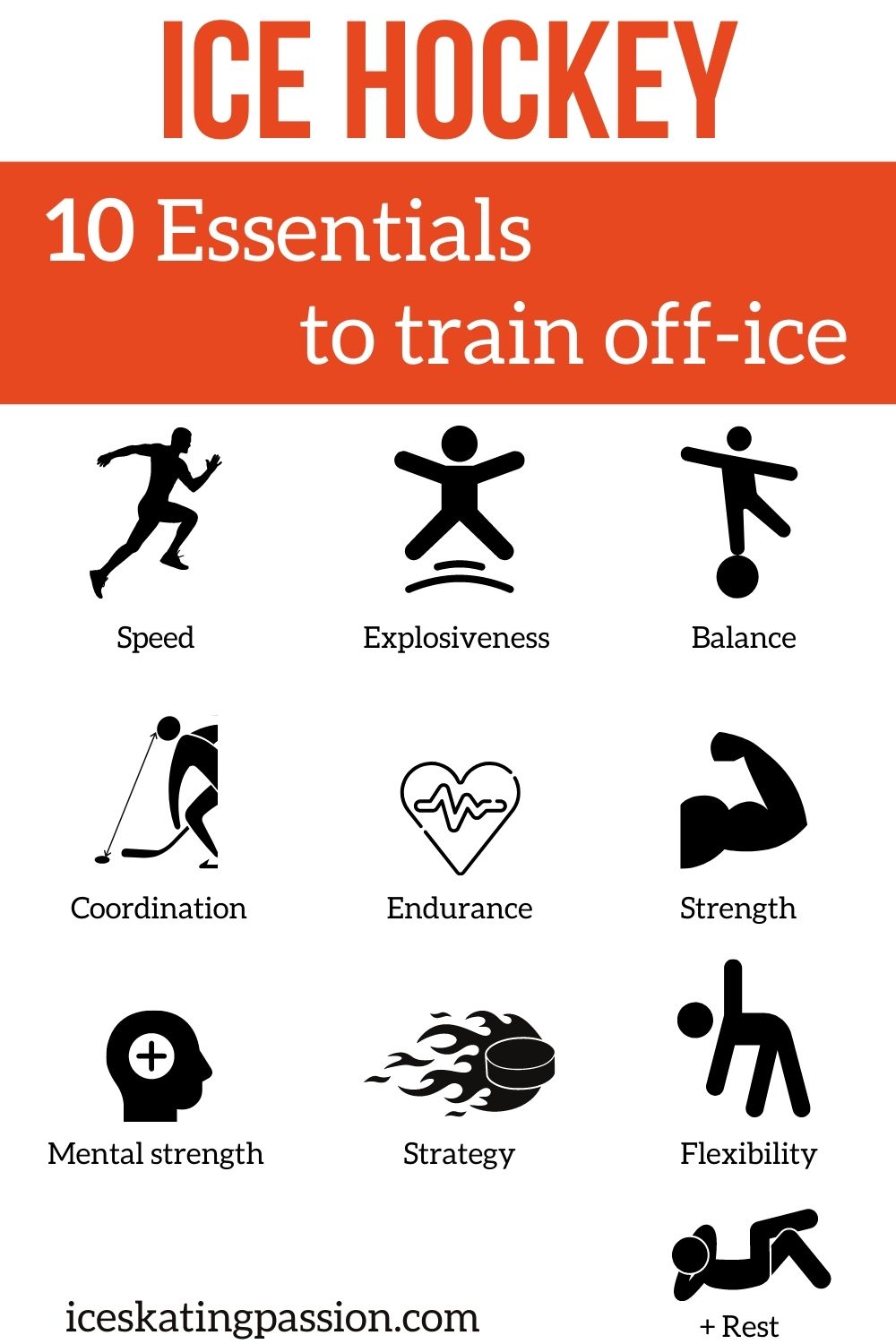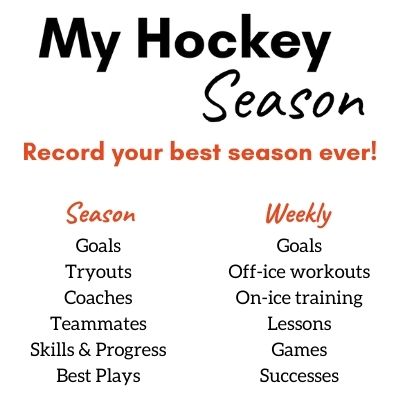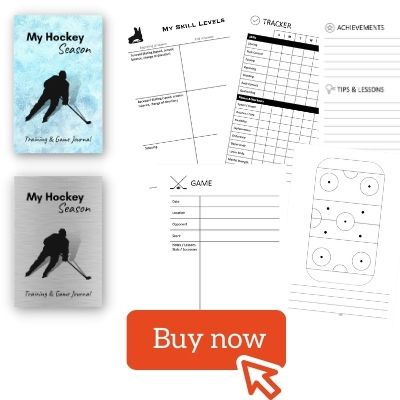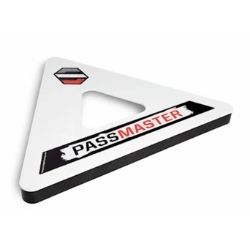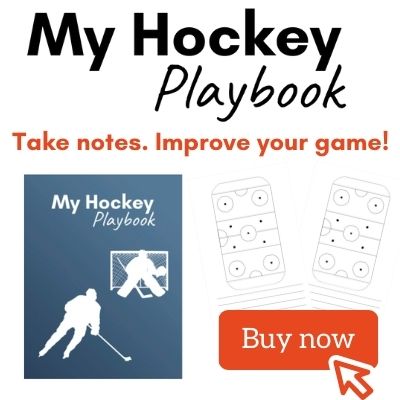Are you looking to improve your hockey results but have limited time on the ice?
Hockey off-ice training is as important as on-ice practice - there is much you can work on without having access to the rink.
Below are the 10 elements to focus on during your hockey workouts off ice (and drills). Plus, I include the types of exercises to consider and equipment that can help you.
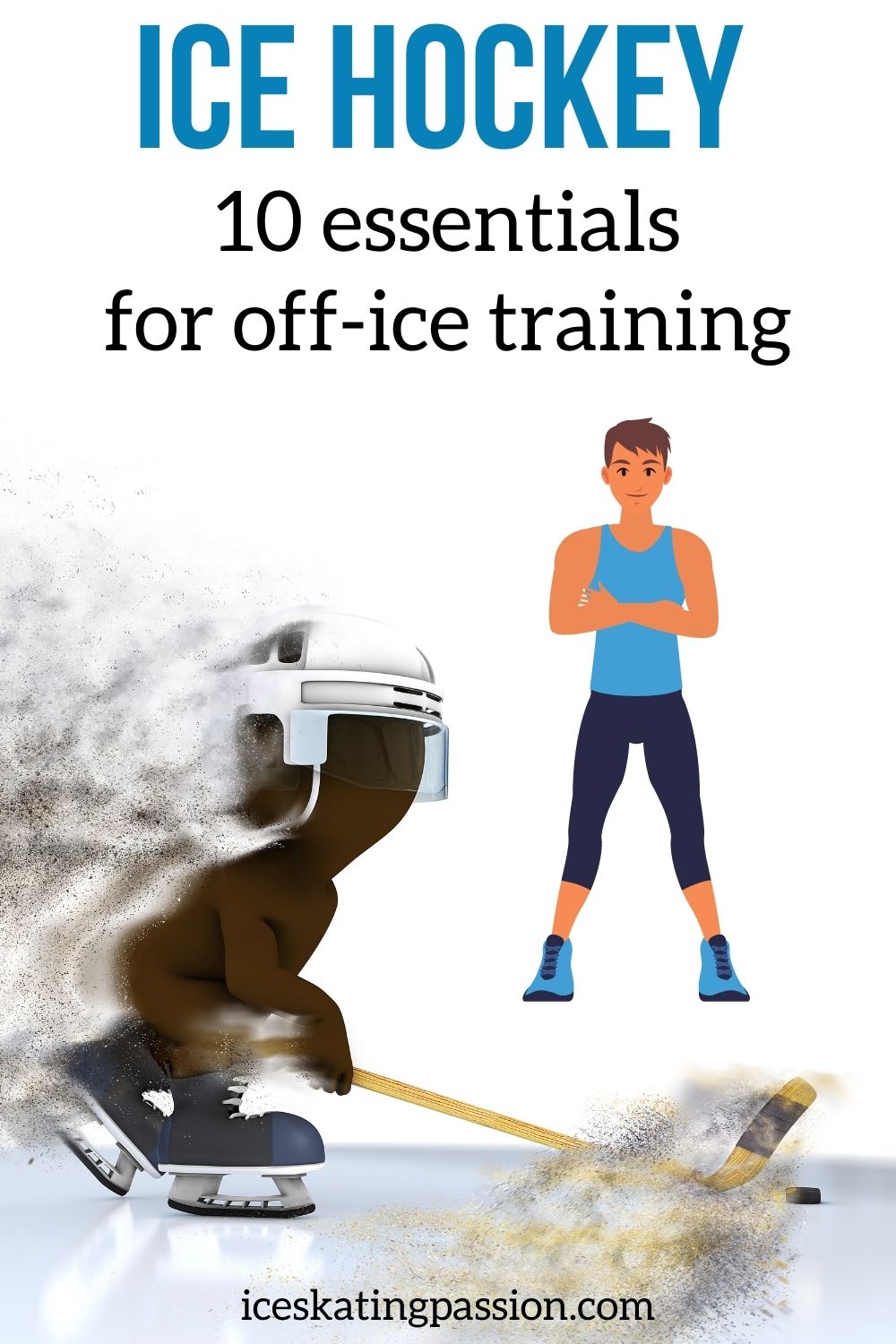
This article contains affiliate links. If you purchase using my link, I get a commission at no extra cost to you (more info here).
Plan your hockey off-ice training routine
Why Work Out Off-Ice?
Ice hockey is a demanding sport.
- Do you want to improve your skills and reach new levels? - skating, avoiding, stickhandling...
- Do you want to learn more difficult skills?
- Do you want to be consistent with your results?
Well, it takes a lot of practice on the ice for the technical aspects.
But it also requires off-ice practice to build your mind and body to be able to reach your goals.
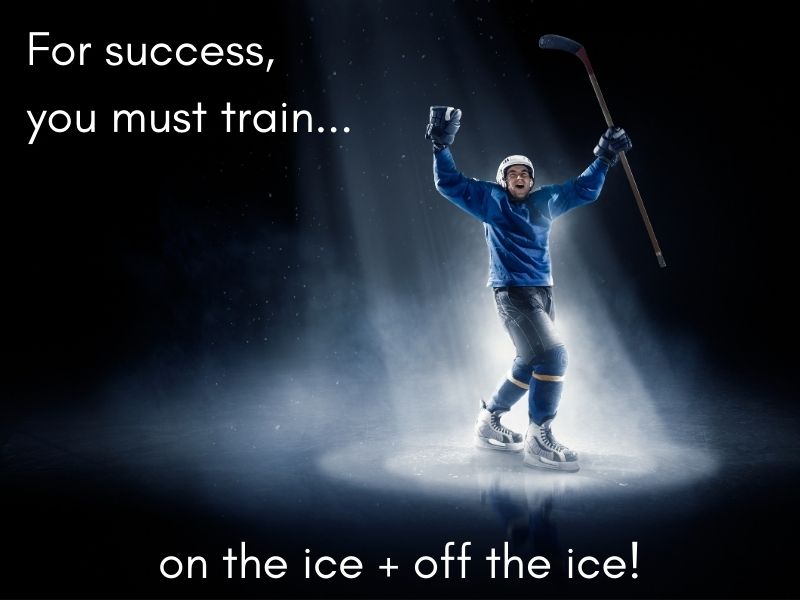
What to work on off-ice to improve your hockey playing?
Below is a summary of all the elements to add to your off-ice training routine - you can learn more about each one with examples of exercises and equipment to help in the rest of the article below.
- Speed
- Explosiveness
- Balance
- Strength
- Coordination
- Endurance
- Mental Strength
- Strategy
- Flexibility
- And don't forget to rest!
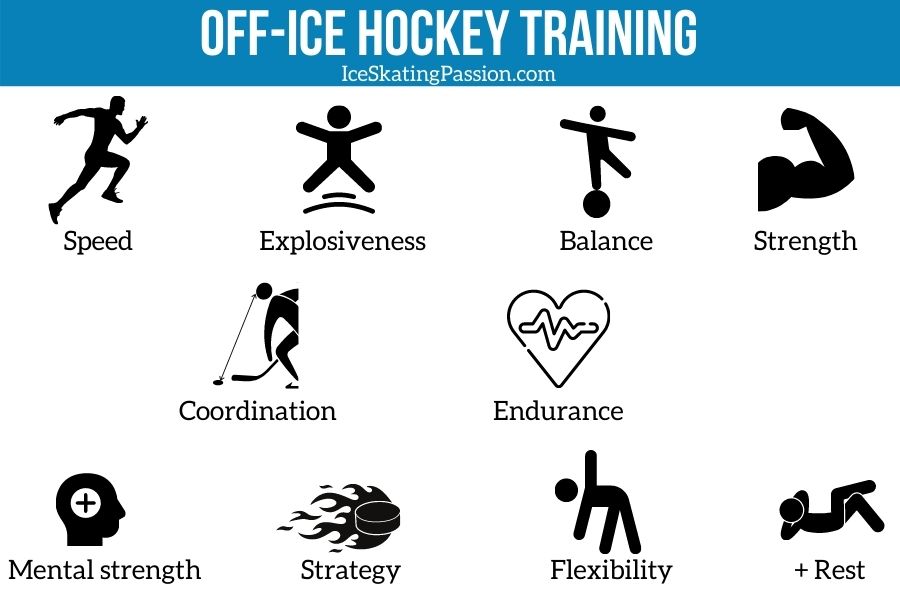
Speed vs Conditioning vs Strength vs Explosiveness
Many words used about off-ice hockey training may create confusion. We will enter in more details in the section about each element, but here is an introduction to help you better understand the differences:
- Conditioning / Endurance training works on your ability to perform a given task longer
- Strength training works on your ability to produce more force
- Speed training works on your ability to perform a given task faster, to properly express your force
- Explosiveness training works on your ability to produce maximum force in minimum time
- Mobility is at the intersection of flexibility, strength, and technique trainings to get the best and most efficient range of motion
- Skill training - you can also practice specific stickhandling skills by doing drills at home - they are included in the coordination, precision, and reflexes section.
All trainings are interlinked. Many exercises can cover 2 or more elements. So, there are no clear boundaries between them.
But if you work reasonably on everything, you should see progress.
Off ice goalie training
Note that training for goalkeepers is quite different than for the other players.
I will cover recommendations in another article
How often to train off-ice?
Your off-ice training schedule should be in alignment with:
- your goals for the season
- your skill levels
- your on-ice training quantity (on / off season)
- your games
- other sports you might be practicing
There is no "one-size fits all" answer.
- Beginner youth hockey players should try to work on each element at least once a week.
- Most pros spend 2 h working out off the ice for every hour on the ice
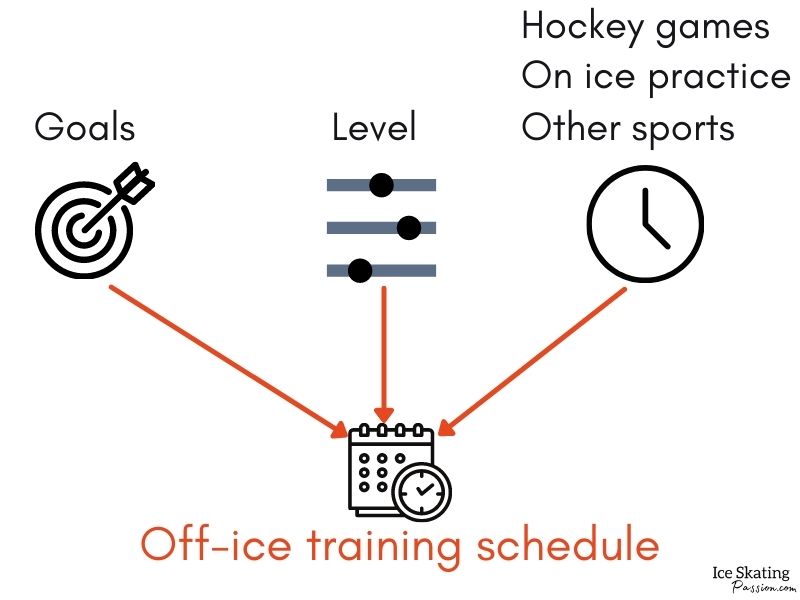
Defining your off-ice hockey training routine
- Your training plan should be in alignment with practicing for a goal - therefore it should vary with the seasons
- Your training program should take you towards progress.
- Choose your training schedule with a healthy vision - do not do things in excess and plan time to rest
- Make sure to plan variety in your exercises to not overtrain one muscle
- A health professional can give appropriate advice regarding techniques related to specific exercises. Consult one. By working with a qualified specialist, you avoid injuries and receive tremendous benefits.
Start by listing your goals, and how much training you will do in each category (how often, for how long and how intense) (this can vary every 4 weeks depending on your on-ice activity)
Check out the specialized notebook to record your training and progress for the season:
#1 - Improve Speed
Why work on speed?
Speed is one of the essentials of all successful hockey players.
The puck flies on the ice very fast.
You need to be able to skate the whole length of the ice rink at full speed, to change position and help defend or attack as soon as possible.
Half an inch can be the difference between you getting the puck or not, and between you stopping a move or not.
And for that you need speed (once you are launched) and explosiveness (to accelerate very fast). Here we will talk about the first and we will cover the second in (#2).
For speed development in hockey, you need:
- Greater Stride length: The length (or) distance covered in one single running stride.
- Greater Stride frequency: The number of steps taken per unit of distance covered.
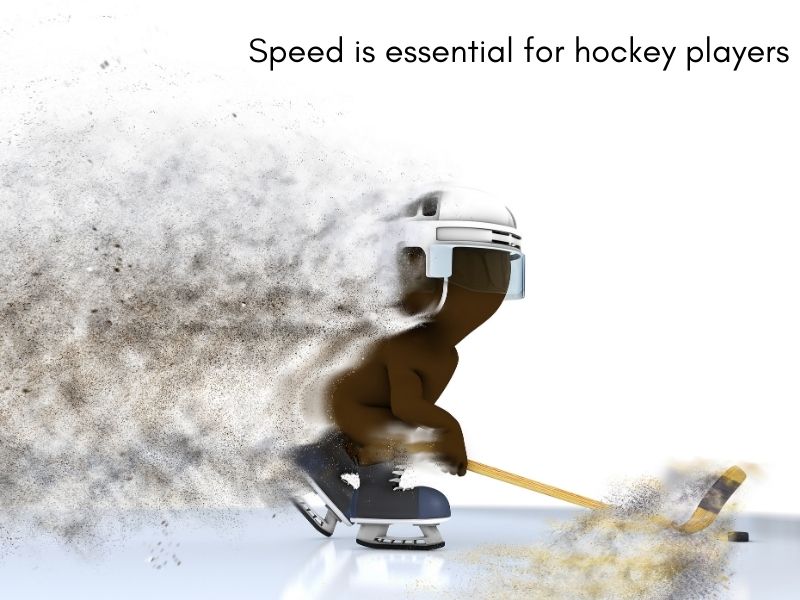
How to work on it? Workout / Drills
All the elements you are going to work on in the next sections (agility, strength, balance...) will participate in improving your speed. There are not many speed specific exercises to work on.
But you can also add exercises that are specific.
And if you want to improve your speed, work at all-out levels with longer rest periods.
To improve your skating speed, you can work on speed workouts that include:
- Sprints
- Intermittent sprints
- Up-hill and down-hill sprints
- Sled dragging
- All the strength, mobility and explosiveness exercises listed in the next sections.
Equipment to help
The problem with running is that it does not completely cover the elements of a skating stride.
So you improve part of your hockey speed elements but not all.
The moves are not the same after all.
One of the main off-ice hockey training equipment that can help to work on your stride frequency is the slide board.
#2 - Improve Explosiveness
Why work on Explosiveness?
Hockey is a fast sport. Fast in terms of speed and in terms of changes in direction.
A hockey player must be able to react to the situation and activate his/her muscles as fast as possible to start speeding in the right direction.
The muscle fibers must be able to contract and relax very fast and repeatedly.
How to work on it? Workout / Drills
A lot of the explosiveness training can be done with jumps. But for hockey players, you need jumping workouts that are:
- initiated with greater hip and knee flexion,
- with angles closer to the skating positions,
- with longer ground contact durations.
You should complete the classic jump exercises by starting them from a down position:
- Long jumps
- Jumps over benches
- Burpees
- Sprints on slopes
- Plyometric jumps - consisting of jumping on and off a box with various heights
- Sprint started with one knee on the ground turned 45°C from the running direction
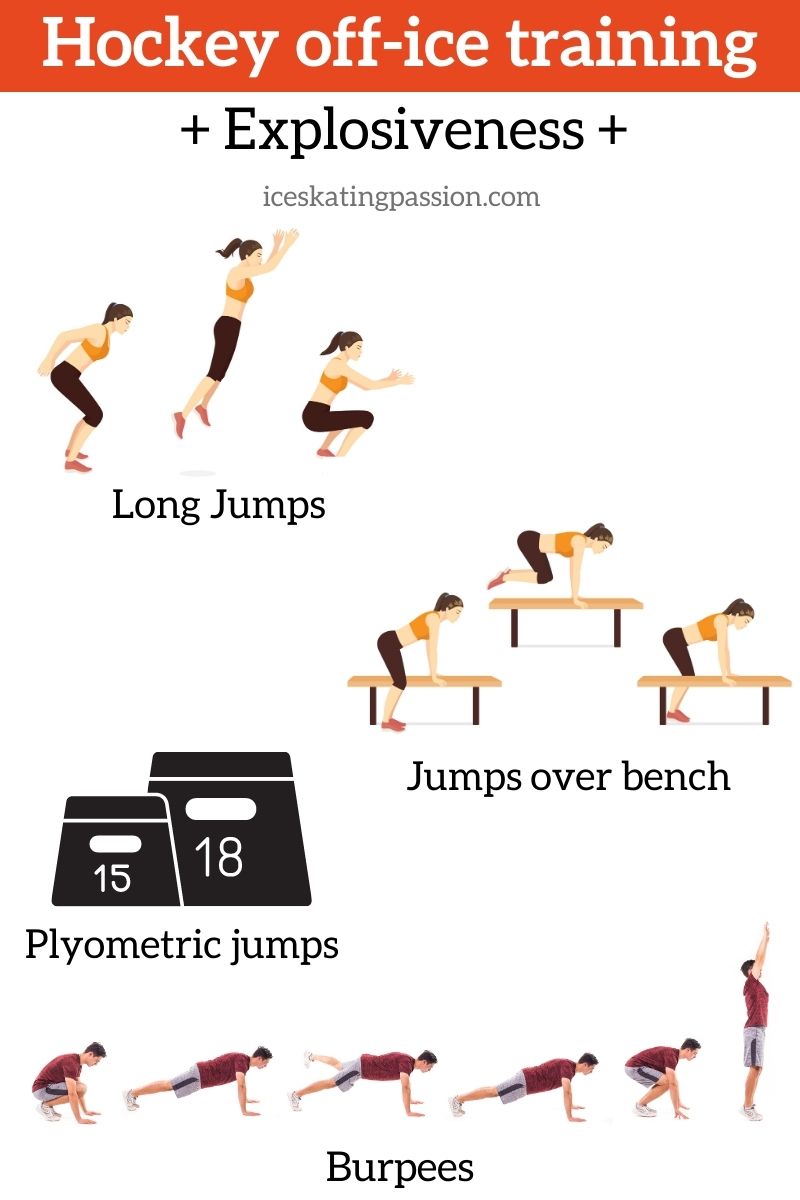
Equipment to help
The jump box is a great tool to help you improve.
It can be turned into different position to increase the difficulty of your exercise as you progress.
#3 - Improve Balance & Core
Why work on balance and core strength?
Maneuvering on ice, on a thin blade, will always be more difficult than running up and down a soccer field...
Therefore hockey players require better balance than many other sports.
Plus, hockey is a frantic game with many dynamic elements.
Hockey players need to be able to:
- adapt to the game and change the direction of their momentum as fast as possible
- resist assaults on their balance
- handle the stick
- take slapshots
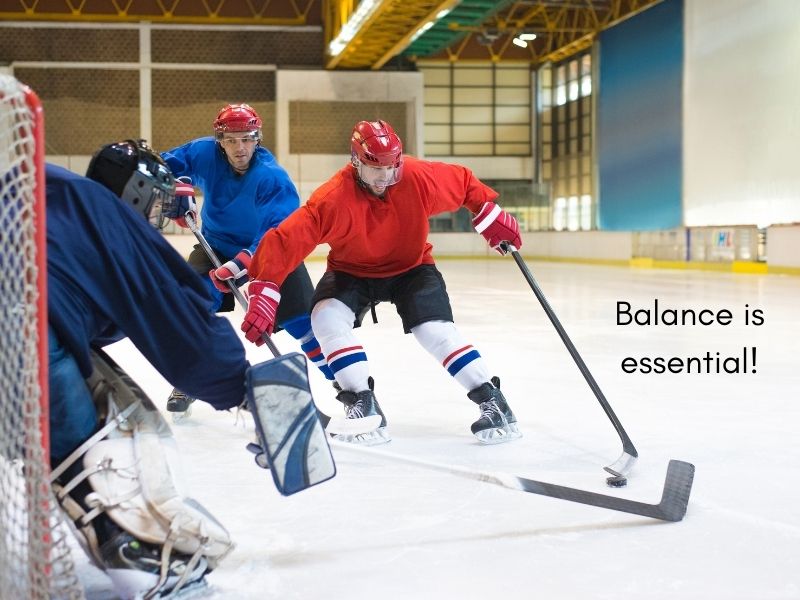
How to work on it? Workout / Drills
Balance exercises include:
- Standing on one leg - and then increasing difficulty by moving free leg
- One-leg squatting
- One-leg hopping
- Standing on tip toes
Working on core strength is essential to increase balance. The muscles in the back and abdomen hold your core strength. They are the control centers of your body. Typical core exercises using your body weight:
- The plank - rest your forearms on the floor
- Side plank
- Sit-up
- Crunches and reverse crunches
- Bird dog movement
- V-ups
- Mountain climber
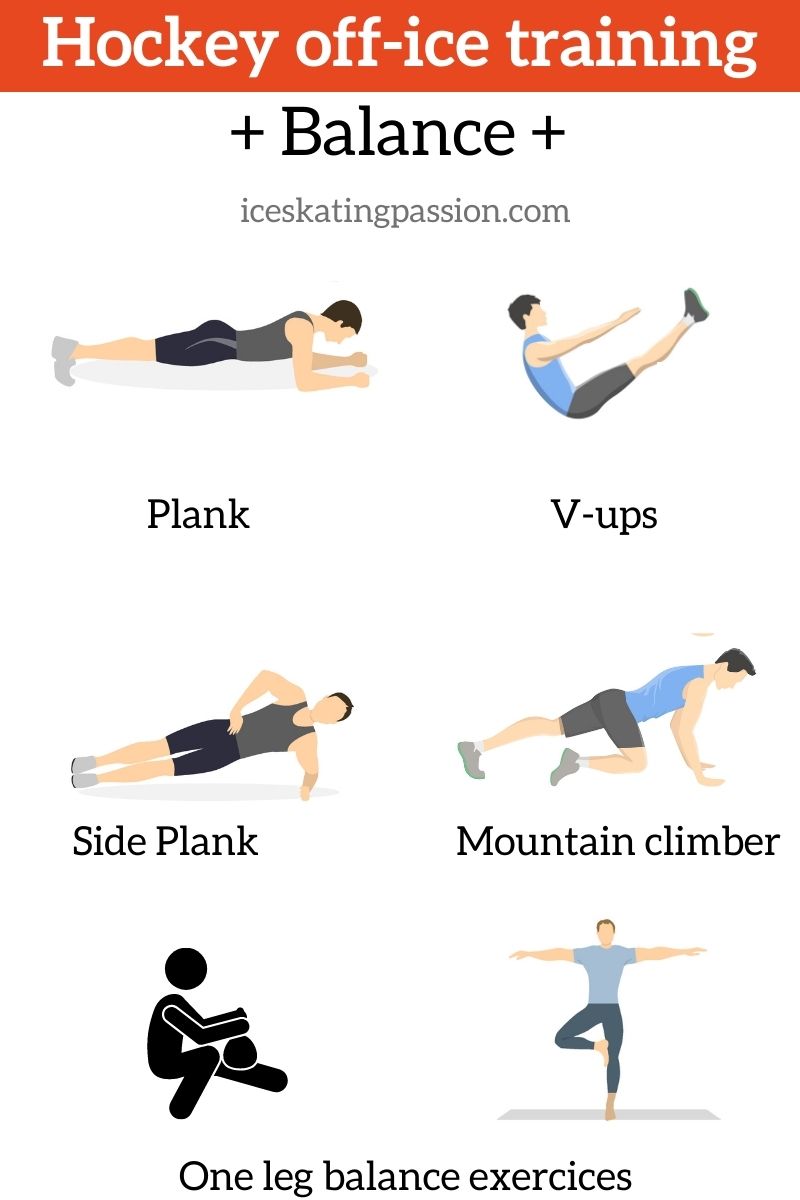
Equipment to help
- Balance Board - a tool that is loved by hockey players is the balance board. It is a good exercise and fun at the same time - Check out my complete article to choose the best balance board for you
- The Half ball balance trainer will allow you to add diversity to your core strength exercises and add a balance element to it - With it you can do push-ups, squats, crunches, lunges, planks...
- The core sliders to be used on hardwood floors or carpets - They complement the core strength exercises allowing movement with sliding hands or feet.
Other activities that help with core strength
- Swimming
- Trampoline - get a practice one for home
- Climbing
- Pilates
- Gymnastics
- Yoga
#4 - Improve Hand-Eye coordination, Precision & Reflexes
Why work on Coordination and Reflexes
Hockey is a challenging sport, there are many things going on:
- you must balance on skates
- you must survey the whole rink to keep track of the small but fast puck (with peripheral vision and depth perception)
- you must control your stick
- you must locate your teammates
- you must fend off the opposite team.
Therefore, your coordination (especially hand-eye) and your reflexes are essentials to your success.
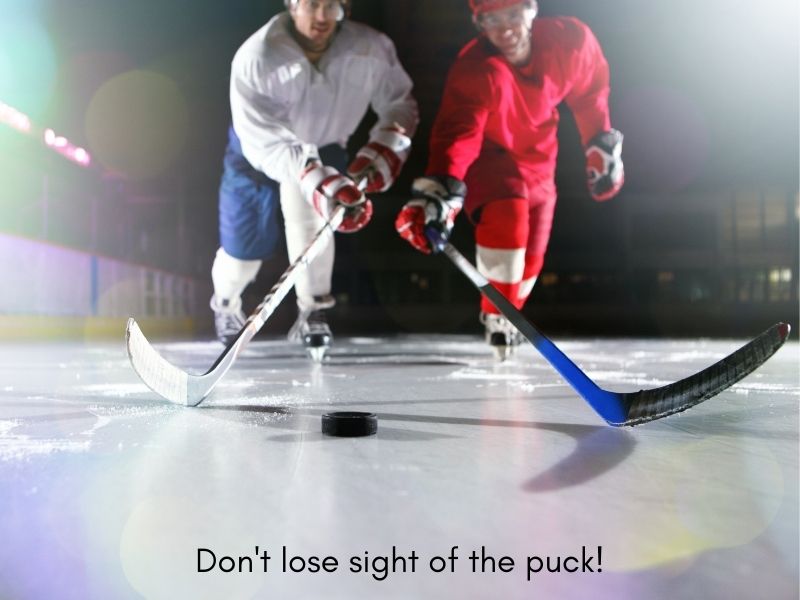
How to work on it? Workout / Drills
Anything that requires doing several exercises at the same time such as:
- throwing a medicine ball at a wall while doing squats
- playing catch with a tennis ball
- juggling
- Doing fitness exercises while balancing a puck on the stick (jumps, runs...)
Equipment to help & off-ice hockey Drills
You can also practice specifically for hockey with equipment that can be used off the ice.
You can practice controlling the puck and shooting - doing repetitive drills passing and receiving the puck.
- Shooting pads and tiles - see my selection and tips
- Nets and Targets and Shooting tarps - see my selection and tips
- Passing aids and rebounders - see my selection and tips
- Stick-handling tools - see my selection and tips
And don't forget to wear your hockey gloves, to imitate on-ice practice!
#5 - Improve Endurance and Stamina
Why work on Endurance / Stamina?
No matter the age or skill level, hockey players required great endurance.
You should be able to keep the same level of performance until the end of the game!
If you feel that you are burning out by the end of hockey practices or game, you must work on your stamina.
Despite being on the ice for short period of times, you must speed across the ice while keeping focus. And this intensity must be sustained.
And the best way to increase it, is by off-ice workouts. After a while, your body will become used to exercise and you won’t tire out as fast.
How to work on it? Workout / Drills
The best way to develop your stamina that is adapted to the practice of ice hockey is through interval training: i.e. Exercises with short bursts of energy followed by a recovery period (like you would have to do during a game).
Typically, the average shift in a hockey game is 45 seconds.
And over a game, a player will get an average of 20minutes of ice time.
So the player will have to play a minimum of 20 shifts per game (which means 20 bursts of energy).
Interval training means switching between two activities that require different rates of speed and degrees of effort.
Off the ice (and without equipment) you can:
- Run sprints (and jog in between)
- Run up hill (and walk down hill)
- Do bursts of jumping jacks or burpees (and walk in between)
- Jump ropes (and walk in between)
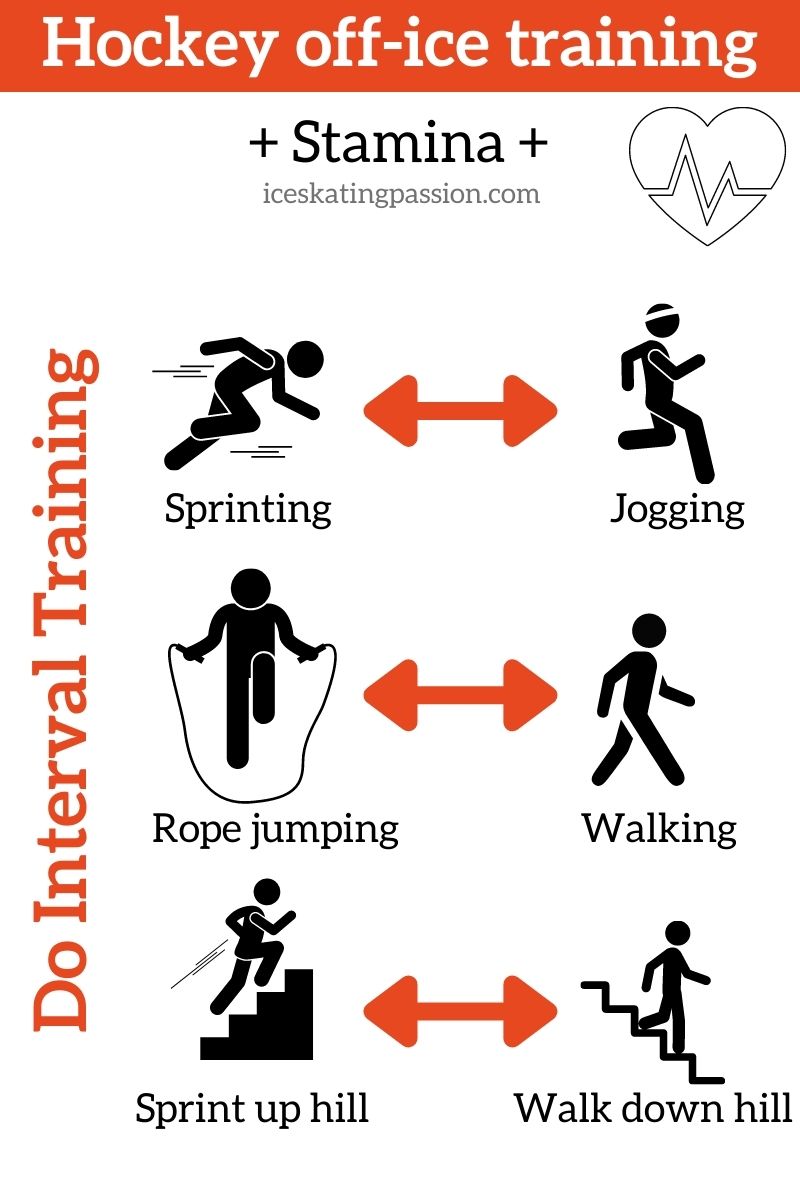
Equipment to help
If you can't go outside to train, or you prefer to work out with equipment, you can easily do interval training with:
- a stationary bike or a spin bike
- an elliptical trainer
- a treadmill
- a rowing machine
And don't forget to hydrate!
#6 - Improve Body Strength (Upper and Lower)
Why work on Body Strength
We have already covered core strength in #3 Improve balance.
But hockey players should also work on Upper and Lower body strength for faster skating, better balance, better control, and stronger shots.
How to work on it? Workout / Drills
The best strength for them is the explosive one (as seen in #2) - therefore exercises with greater weight but lower repetitions are best.
But you can also work on simple sets of exercises such as:
- Squats (and alternatives: single leg squat, front squat, high bar squats, low bar squats) - a classic in strength and conditioning because you work on many muscles and is a very functional exercise.
- Pull-ups and Chin-ups
- Push ups
- Deadlift - great for explosive strength (and vary leg positions)
- Bench Press and all its version (preference for standing position as if skating)
- Dumbbell exercises
- Throwing a medicine ball against the wall
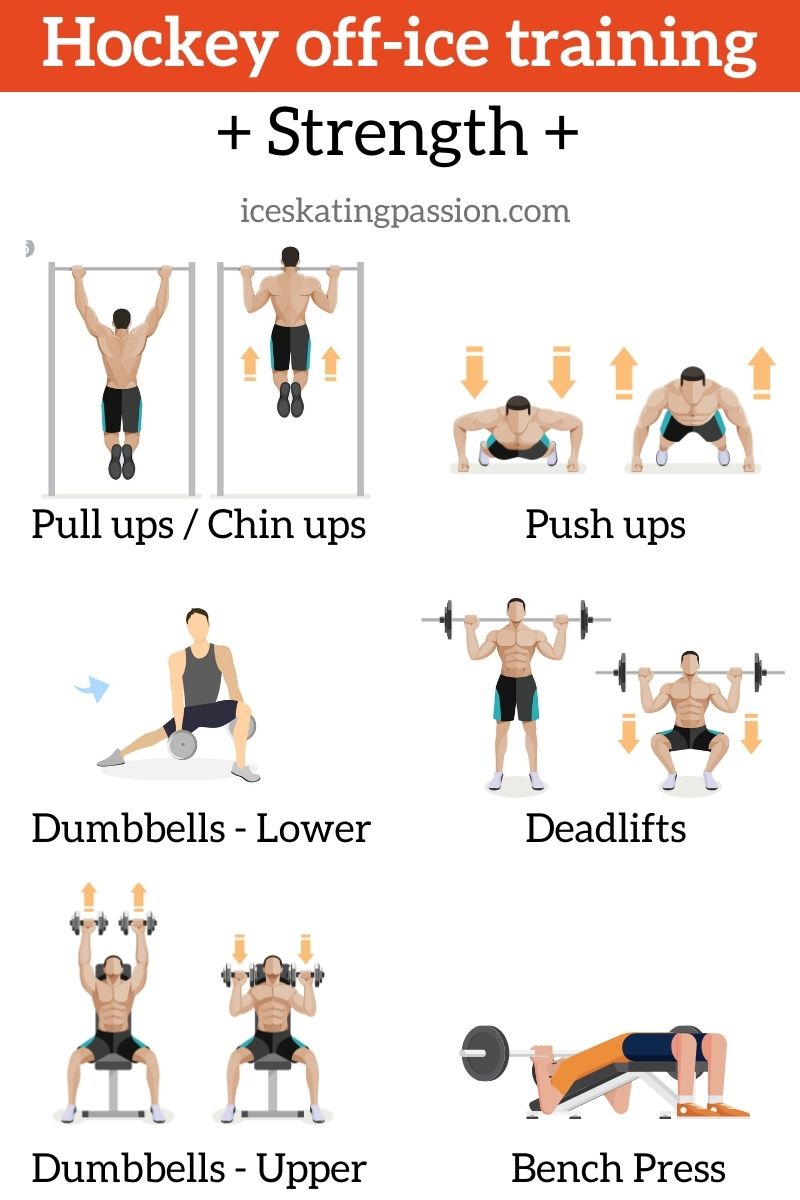
Equipment to help
A lot of strength exercises can be done only with your body weight.
But people often prefer working out with weights and equipment. Here are some suggestions:
#7 - Improve Mental Strength
Why work on mental strength?
It is important to possess good mental equilibrium too. However, many trainers overlook this aspect completely. You must be calm on the ice. The body will follow the mind.
You must first explore your reasons for taking up hockey. What do you love about it? How does it make you feel?
And then you should work on:
- Visualization
- Meditation
- Mindfulness
Below are a few books that could help you get to the next level by working on your mind:
And check out some of my favorite quotes about hockey!
#8 - Improve Strategy Thinking
Why work on Strategy
Hockey is a very strategic and complex game with lots of players.
Your coach has been working hard on his tactics and you should make sure you understand them fully.
And you should also learn from the other teams and see what is working.
How to work on it? Workout / Drills
Look back at your own games and look at other teams' games
- Draw the situations on the paper on ice rink templates
- Take notes about them, about the players, about their skills
- Write down recommendations from your coach so that you can read them again later and apply them
- Write down ideas about how you can improve
If you want a notebook version to improve your strategy thinking, check out the My Hockey Playbook:
#9 - Improve Flexibility
Why work on flexibility and agility
For speed sports, athletes tend to overlook flexibility, even though it is essential for their speed!
Hockey players must optimize their flexibility to be able reach peak performances
What is flexibility? It is the range of motion of a joint.
If your flexibility is limited, you are limiting:
- your range of motion,
- your speed,
- your balance,
- and the capacity of your body to counteract extreme positions to avoid injuries
But it must not be taken to the extreme. A hockey player does not need to be flexible like a dancer.
How to work on it? Workout / Drills
Hockey players should always make it a habit to stretch:
- Dynamic stretches (sport-specific) before workouts or games
- Static stretches (deep, slow stretches) after the workouts or games or/and on other days
Example of dynamic stretches:
- Jumping jacks
- Arm circles
- Arm rotations
- Lateral lunges
- Front lunges
Examples of static stretches:
- Quad stretches
- Hip flexor stretches (with rear foot elevated for increase)
- Calf/Achilles tendon stretches
- Hamstring stretches
- Glute stretches
- Deltoid/pectoral - Shoulder stretches
- Neck stretches
- Wrist stretches
- ....
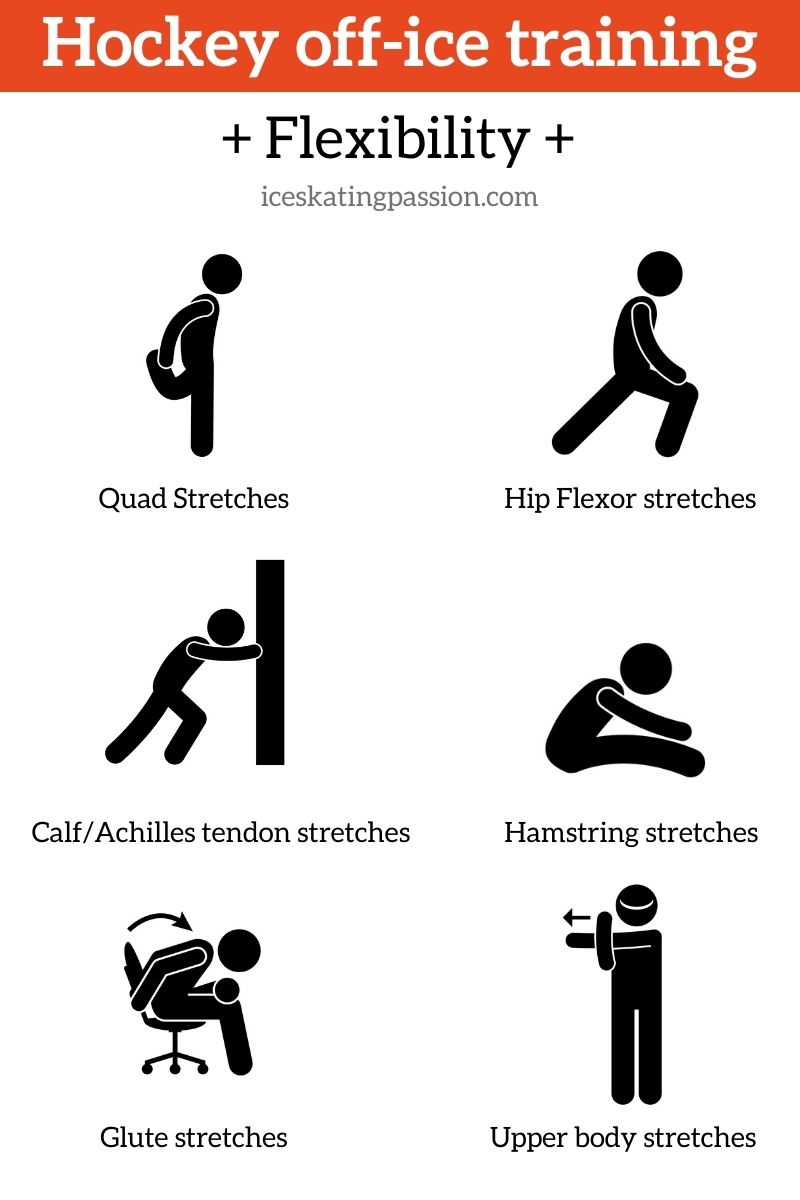
Equipment to help
Simple stretches are sufficient for hockey players. You don't need deep flexibility.
However if you want to stretch your back, the Yoga Wheels can help you - Get Yoga wheels
Otherwise here are some mats for you to stretch with hockey style:
#10 - Rest between off ice workouts for hockey players
Such hectic activity should be followed by rest. Your body must have time to recover from the stress and strain. Therefore, do take some time off from your off-ice training program.
Note that when you are training off-ice, your muscle fibers are breaking down. Only a nutritious regimen and appropriate rest can bring their strength back to normal. Therefore, include rest in your exercise schedule. Your body must have time to recover its strength.
You might also be interested in:
